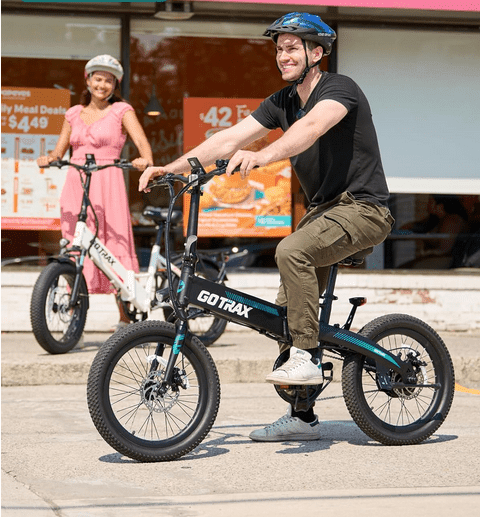Are you tired of your electric bike battery running out of juice too quickly? Look no further – this ultimate guide is here to help you maximize the lifespan of your electric bike battery. Whether you're a seasoned e-biker or new to the electric bike world, understanding how to take care of your battery is essential for optimal performance and longevity.
In this comprehensive guide, we will walk you through step-by-step strategies to extend the life of your electric bike battery. From proper charging techniques and maintenance tips to storage advice and common mistakes to avoid, we've got you covered.
Discover the dos and don'ts of charging and learn how to effectively care for your battery to ensure it lasts longer and performs at its best. By following our expert tips, you'll be able to enjoy more rides, cover longer distances, and maximize the overall lifespan of your electric bike battery. Say goodbye to range anxiety and hello to extended battery life. Let's dive in and keep you riding for longer!
 Why is battery lifespan important?
Why is battery lifespan important?
The battery is the heart of your electric bike, and its lifespan is crucial for the overall performance and longevity of your e-bike. A well-maintained battery can provide you with years of reliable service, allowing you to enjoy the convenience and benefits of electric-assisted cycling for an extended period. However, a poorly cared-for battery can quickly deteriorate, leading to reduced range, diminished power, and the need for costly replacement.
Maximizing the lifespan of your electric bike battery is essential for several reasons. Firstly, it helps to ensure that you get the most value for your investment. Electric bikes can be a significant financial investment, and extending the life of the battery can help you get the most out of your purchase. Additionally, a longer-lasting battery means fewer battery replacements, which can save you money in the long run.
Furthermore, a well-maintained battery contributes to the overall sustainability of your electric bike. By reducing the need for frequent battery replacements, you can minimize the environmental impact and resource consumption associated with battery manufacturing and disposal. This aligns with the eco-friendly ethos of electric bikes and helps to make your mode of transportation more sustainable.
Factors that affect electric bike battery lifespan
Several key factors can influence the lifespan of your electric bike battery. Understanding these factors is crucial in developing effective strategies to maximize the battery's longevity.
One of the primary factors is the battery's chemistry and construction. Different battery types, such as lithium-ion (Li-ion) or lithium-polymer (Li-Po), have varying characteristics that affect their lifespan. Li-ion batteries, for example, are generally more durable and have a longer lifespan compared to older battery technologies.
The frequency and depth of discharge also play a significant role in battery lifespan. Repeatedly draining the battery to a low level can accelerate its degradation, while keeping the battery at a moderate state of charge can help preserve its capacity over time. Additionally, the temperature at which the battery is used and stored can have a significant impact, with extreme heat or cold negatively affecting the battery's performance and longevity.
The quality of the battery itself is another crucial factor. Higher-quality batteries from reputable manufacturers tend to have better build quality, more robust construction, and advanced battery management systems that help to extend the battery's lifespan. Investing in a high-quality replacement battery can be a wise decision to ensure long-term performance and reliability.
Understanding battery maintenance and care
Proper maintenance and care are essential for maximizing the lifespan of your electric bike battery. By following a few simple steps, you can ensure that your battery stays in optimal condition and continues to deliver reliable performance for years to come.
One of the most important aspects of battery care is proper charging. Avoid overcharging the battery, as this can lead to accelerated degradation. Similarly, it's important to avoid completely depleting the battery, as this can also have a negative impact on its lifespan. Instead, aim to charge the battery when it reaches around 20-30% and stop charging once it reaches 80-90% capacity.
Proper storage is another critical element of battery maintenance. When not in use, store the battery in a cool, dry place, away from direct sunlight or extreme temperatures. If you plan to store the battery for an extended period, it's recommended to charge it to around 50% capacity to minimize the risk of over-discharge or over-charge.
Regular cleaning and inspection of the battery and its connections can also help to extend its lifespan. Wipe down the battery terminals and ensure that all connections are secure and free of corrosion. If you notice any signs of damage or abnormal behavior, it's important to address them promptly to prevent further degradation.
Tips for maximizing battery lifespan
In addition to proper maintenance and care, there are several tips and strategies you can implement to maximize the lifespan of your electric bike battery. By following these best practices, you can ensure that your battery continues to perform at its best for years to come.
One of the most effective ways to extend battery lifespan is to avoid exposing it to extreme temperatures. Extreme heat or cold can accelerate the battery's degradation, so it's important to protect the battery from these conditions. If possible, store your electric bike in a temperature-controlled environment, and avoid leaving it in direct sunlight or extremely cold conditions for prolonged periods.
Another important tip is to avoid overcharging the battery. While it's tempting to keep the battery plugged in at all times, this can actually be detrimental to its lifespan. Instead, aim to charge the battery only when necessary, and unplug it once it reaches the recommended charge level (typically 80-90%).
It's also a good idea to avoid completely draining the battery. Regularly discharging the battery to a low level can put significant stress on the cells, leading to faster degradation. Instead, try to keep the battery at a moderate state of charge, cycling between 20-80% whenever possible.
Proper charging techniques for electric bike batteries
Proper charging techniques are crucial for maximizing the lifespan of your electric bike battery. By following a few simple guidelines, you can ensure that your battery is charged safely and efficiently, without compromising its long-term performance.
One of the most important things to remember is to use the correct charger for your specific battery. Using a charger that is not compatible with your battery can lead to overcharging, undercharging, or even damage to the battery. Always use the charger that came with your electric bike or one that is explicitly recommended by the manufacturer.
When charging your battery, it's best to do so in a cool, well-ventilated area. Avoid charging the battery in direct sunlight or in a hot environment, as this can cause the battery to overheat, which can accelerate its degradation. If possible, charge the battery at room temperature for optimal results.
Another important tip is to avoid leaving the battery on the charger for extended periods once it has reached a full charge. Overcharging can put unnecessary stress on the battery and reduce its overall lifespan. Once the battery has reached 100% capacity, unplug the charger and disconnect the battery.

Common mistakes to avoid when using an electric bike battery
While proper maintenance and care are essential for maximizing the lifespan of your electric bike battery, it's also important to be aware of common mistakes that can lead to premature degradation. By understanding and avoiding these mistakes, you can help ensure that your battery continues to perform at its best for years to come.
One of the most common mistakes is leaving the battery completely drained for an extended period. This can cause the battery to enter a deep discharge state, which can be difficult to recover from and can significantly reduce its overall lifespan. If you know you won't be using your electric bike for a while, be sure to charge the battery to around 50% before storage.
Another mistake to avoid is overcharging the battery. As mentioned earlier, leaving the battery on the charger for too long can lead to overcharging, which can stress the battery cells and reduce their capacity over time. Always unplug the charger once the battery has reached the recommended charge level.
It's also important to avoid exposing the battery to extreme temperatures, both hot and cold. Extreme temperatures can accelerate the chemical reactions within the battery, leading to faster degradation. If possible, store the battery in a cool, dry place and avoid leaving it in direct sunlight or in a freezing environment.
Extending the lifespan of your electric bike battery through upgrades
In addition to proper maintenance and care, there are also several upgrades and modifications you can make to your electric bike to help extend the lifespan of your battery. These upgrades can improve the battery's performance, efficiency, and overall longevity.
One potential upgrade is to install a battery management system (BMS). A BMS is an electronic circuit that monitors and manages the charging and discharging of the battery, ensuring that it is operated within safe parameters. This can help to prevent overcharging, over-discharging, and other issues that can lead to battery degradation.
Another upgrade to consider is a higher-capacity battery. While a larger battery may not directly extend the lifespan of your existing battery, it can provide you with more usable range and reduce the frequency of charging, which can indirectly contribute to longer battery life. Additionally, a higher-capacity battery may allow you to maintain a more moderate state of charge, which is better for the battery's longevity.
You could also consider upgrading to a battery with a more advanced chemistry, such as lithium-ion or lithium-polymer. These battery types tend to have a longer lifespan and better performance characteristics compared to older battery technologies. While the initial investment may be higher, the long-term benefits of a more durable battery can make it a worthwhile investment.
How to dispose of an electric bike battery responsibly
When the time comes to replace your electric bike battery, it's important to dispose of the old one in a responsible and environmentally-friendly manner. Improper disposal of batteries can lead to the release of harmful chemicals and materials, which can have a negative impact on the environment.
The first step in responsible battery disposal is to check with your local authorities or the manufacturer of your electric bike to see if they have any specific guidelines or programs in place for battery recycling. Many municipalities and manufacturers offer battery collection and recycling services, which can ensure that the materials are properly handled and reused.
If there are no specific programs available in your area, you can typically take the battery to a local hazardous waste collection facility or an electronics recycler. These facilities are equipped to handle the safe disposal and recycling of lithium-ion and other types of batteries, ensuring that the materials are properly contained and processed.
It's important to note that it's generally not recommended to simply throw an electric bike battery in the trash, as this can lead to the release of hazardous materials into the environment. By taking the time to properly dispose of your battery, you can help to minimize the environmental impact and contribute to the sustainability of electric bike technology.
Conclusion and final thoughts
Maximizing the lifespan of your electric bike battery is essential for getting the most out of your investment and ensuring a reliable and enjoyable riding experience. By understanding the factors that affect battery longevity, implementing proper maintenance and care practices, and avoiding common mistakes, you can extend the life of your battery and enjoy many years of electric-assisted cycling.
Remember, a well-maintained battery not only saves you money in the long run but also contributes to the overall sustainability of your electric bike. By following the tips and strategies outlined in this guide, you'll be able to keep your battery performing at its best, allowing you to ride farther, explore more, and enjoy the benefits of electric-assisted cycling for years to come.
So, take the time to understand your battery, implement the best practices, and be proactive in its care. With a little effort, you can ensure that your electric bike battery continues to power your adventures for the long haul. Happy riding!






